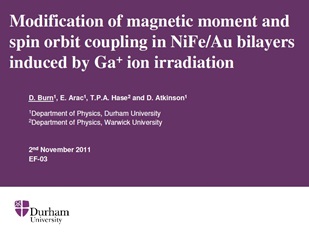
Modification of magnetic moment and spin orbit coupling in NiFe/Au bilayers induced by Ga+ ion irradiation
D.M. Burn, E. Arac, T.P.A. Hase and D. Atkinson
Magnetism and Magnetic Materials Scottsdale, AZ Nov 2011
The effect of low dose focussed ion beam (FIB) Ga+ irradiation on the structural and magnetic properties of NiFe/Au bilayer systems have been investigated. Irradiation induced modifications of the structural and chemical properties within the bilayer result in complex and unexpected changes to the magnetisation, magnetoresistance and fluorescence within the sample.
The structural changes resulting from low dose irradiation have been studied in detail using synchrotron radiation for grazing incidence x-ray reflectivity and angle dependent x-ray fluorescence. Analysis shows roughening at the NiFe/Au interface and the development of a compositionally graded NixFeyAu(1-x-y) alloy. At low dose some Au is lost to sputtering but a consistent Au layer remains on top of the NiFe. Magneto-optical Kerr effect (MOKE), VSM and SQUID measurements show a loss in ferromagnetic signal with increasing dose and also an increased coercivity from an increased density of pinning sites. More interesting is the complex dose dependent change in magnetisation that shows a reduction followed by a recovery of the magnetisation at low dose. This dip in magnetisation is also coincident with a maximum in the anisotropic magnetoresistance ratio (AMR) despite an increase in average resistivity. X-ray fluorescence ratio of Ni to Fe also shows unexpected changes with low dose irradiation, despite the presence of a gold capping layer.
These results indicate that low dose irradiation can have a significant effect on the magnetic moment and from the AMR, on the spin-orbit coupling. Supporting work using XMCD to differentiate the spin and orbital contributions to the magnetic moment are scheduled and will be included in this work.